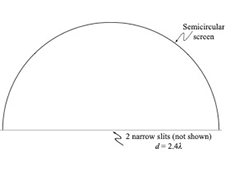
Multiple-slit interference
Variant i Dynamics first
Students extend what they have learned about interference of light passing through two narrow slits to light passing through an arbitrary number of evenly- spaced identical slits.
Topics Waves and optics / Physical optics: models, representations, periodic circular waves, wave front diagrams, and physical optics
Materials
Materials by the UW team
- Group Handout


- Instructor Guide


- Pretest


- Exam Questions



- Equipment List

Tutorial details
Students start the tutorial by determining the locations of the maxima and minima for two very narrow slits that are d = 2.4λ apart. In the second section, they are guided to determine the effect on the interference pattern of adding a third slit a distance d to the side of the original two slits. Students first consider a point at which there is maximum constructive interference for the original two slits. By considering path length differences, they come to recognize that maxima remain maxima as one or more slits are added in this way. The term principal maximum is introduced to identify a location at which light from all of the slits is in phase.
Students then consider how the minima are affected by the addition of the third slit. They find that the location of a point of zero intensity for two slits will no longer be a point of zero intensity, but it will also not be as bright as a principal maximum. Using transparencies of sinusoidal curves to represent the light waves, students are guided to recognize that there will be minima at distant points for which ∆Dadj (the difference in distances to adjacent slits) is λ/3, 2λ/3, 4λ/3, 5λ/3, 7λ/3, etc. Students then develop the equations necessary to determine the angles for which there will be minima and principal maxima for three slits with adjacent slits separated by d = 2.4λ. They compare and contrast their results for the two-slit and three-slit cases. They come to realize that the principal maxima have the same locations in the two cases, but there are two minima between adjacent principal maxima in the case of three slits whereas there was only one minimum between adjacent maxima in the case of two slits.
Students then consider what happens when a 4th slit is added, and then generalize their results to N slits. They find that there are N-1 minima between adjacent principal maxima and that there are minima at points for which ∆Dadj is a whole number multiple of $\frac{λ}{\textit{Nmath}}$ that is not itself a whole number multiple of λ. In the final part of the tutorial, students apply the ideas they have developed earlier in the tutorial to predict how the pattern that appears on the screen changes as more slits are added.
For instruction tips, login or register as a verified educator to see the Instructor Guide.
Prerequisites
Prerequisite tutorials
The Two-source interference tutorial is a prerequisite to Multiple-slit interference.
Equipment
Special Instructions
- 6 envelopes, each containing:
- 1 graph of a sinusoidal curve (in a plastic protector), with horizontal axis marked and vertical axis labeled and marked (See the Handouts section in this guide.)
- 3 transparencies of sinusoidal curves identical to those described above but with only the horizontal axis marked. The sine curves can be highlighted with a permanent marker, one in red, one in blue, and one in green. (See handouts.)
- 6 copies of interference patterns (1 through 5-slits) (See handouts.)
List
- handouts
- white board or large sheet of paper with markers
Coming Soon! We hope to release the discussion section on each tutorial soon.

